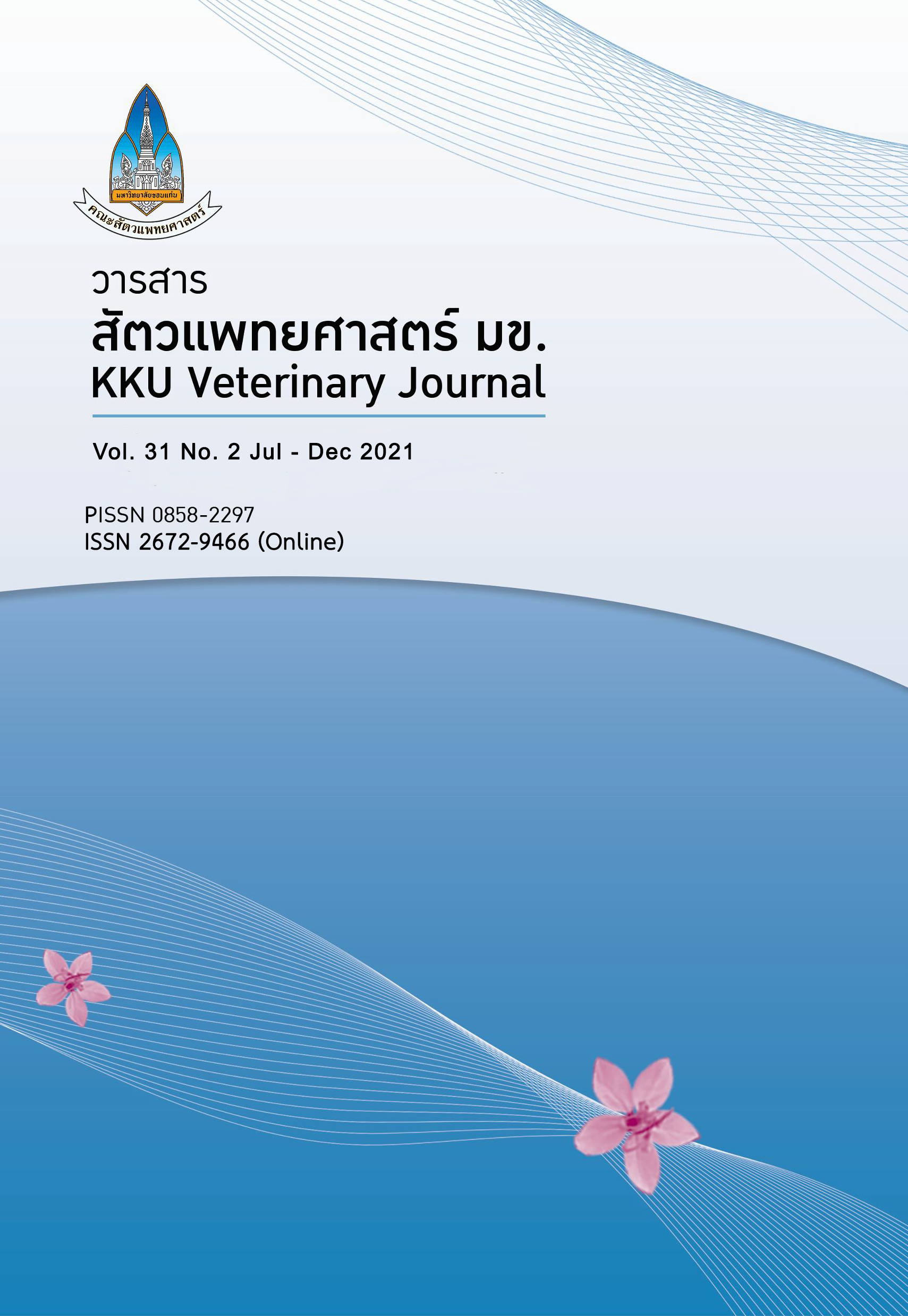Prevalence and risk factors of salmonella spp. In standard Broiler farms and poultry slaughterhouses in central of Thailand
Main Article Content
Abstract
Objective - To investigate the prevalence and risk factors of Salmonella spp. contamination in broiler farms and poultry slaughterhouses as well as studying the risk factors from the assessment knowledge and understanding about working in farms and slaughterhouses to reduce risk factors and development and control of meat quality to ensure quality and safety for consumer
Materials and Methods - One thousand and seventy boot swab samples were collected from 12 collective broiler farms (S1, S2, six farms each), which slaughtered the broilers in slaughterhouse 1 (S1) and slaughterhouse 2 (S2), respectively. Three hundred carcasses rinse and 240 meat(breast,innerfillet) samples were also collected from S1 and S2 each, respectively, from January to December 2018. All samples were cultivated for Salmonella detecting using ISO 6579:2002 method. The questionnaires were used to evaluate risk factors related to the Salmonella contamination using descriptive statistical analysis.
Results - The study showed the prevalence of Salmonella spp. from broilers at F1 and F2 were 2.38 % (15/631) and 41.69 % (183/439) (p < 0.05), respectively. The prevalence of Salmonella spp. from carcasses rinse from S1 and S2 were 0.33 % (1/300) and 15.66% (47/300) (p < 0.05), and from chicken meat from S1 and S2 were 19.16% (46/240) and 7.08% (17/240) (p< 0.05), respectively. The study showed that the farm F2 was higher of in sharing of equipment’s use among houses such as boots, worker uniforms and feed trays than the farm F1 (70.74%, 21.05%). The S1 was delaying cleaning and changing contaminated equipment such as knives, butcher boards, baskets, and meat trays higher than that of the S2 (95.23 %, 2.04 %).
Conclusion - Slaughterhouses should have measures to prevent salmonella cross contamination such as cleaning programe after the equipment used is contaminated. and reduce the prevalence of Salmonella spp. contamination.
Article Details

This work is licensed under a Creative Commons Attribution-NonCommercial-NoDerivatives 4.0 International License.
References
เอกสารอ้างอิง
Abatcha MG, Goni MD, Abbas MA, Jalo IM, Mohammed G, 2020. Review of Listeria and Salmonella: An Update on Description, Characteristics, Incidence, and Antibiotic Susceptibility. Adv Anim Vet Sci 8(11), 1232-1249.
Boonprasert N, Nuanualsuwan S, Pulsrikarn C, Pornaem S, Chokesajjawatee N, 2014. Sources and Dissemination of Salmonella spp. in an Integrated Broiler Meat Production. Thai J Vet Med 44(1), 117-124.
Chullabodhi B, Harintharanon T, Nuanualsuwan S, 2013. Quantitative microbial risk of Salmonella spp. in Chicken meat from retail fresh market to the consumer. J Appl Anim Sci 6(3), 46-52.
Department of International Trade Promotion., 2016. Ministry of Commerce.Thansettakij 36(3139), 6.
Djeffal S, Mamache B, Elgroud R, Hireche S, Bouaziz O, 2018. Prevalence and risk factors for Salmonella spp. contamination in broiler chicken farms and slaughterhouses in the northeast of Algeria. Vet World 11(8), 1102-1108.
Khandekar N, Sharma RP, 2000. Investigations on technological gap in small scale rural poultry farming. Indian J Poult Sci 35(3), 262-265.
Khalid T, Hdaifeh A, Federighi M, Cummins E, Boué G, Guillou S, Tesson V, 2020. Review of Quantitative Microbial Risk Assessment in Poultry Meat: The Central Position of Consumer Behavior. Food 9, 1-26.
Lee K, Runyon M, Herman T, Phillips R, Hsieh J, 2015. Review of Salmonella detection and identification methods: Aspects of rapid emergency response and food safety. Food control 47, 264-276.
Limbergen TV, Dewulf J, Klinkenberg M, Ducatelle R, Gelaude P, Mendez J, Heinola K, Papasolomontos S, Szeleszczuk P, Maes D, 2018. Scoring biosecurity in European conventional broiler production. Poult Sci 97, 74-83.
Mezali L, Mebkhout F, Nouichi S, Boudjellaba S, Hamdi TM, 2019. Serotype diversity and slaughterhouse-level risk factors related to Salmonella contamination on poultry carcasses in Algiers. J Infect in Dev Ctries 13(5), 384-393.
Minharro S, Nascimento CA, Galletti JP, Merisse TJ, Floresta Feitosa AC, Santos HD, Ferreira Dias FE, Santana ES, Baldani CD, Andrade MA, 2015. Antimicrobial susceptibility of Salmonella serovars isolated from edible offal and carcasses of slaughtered poultry in the state of Tocantins, Brazil. Semina: Ciências Agrárias, Londrina 36(4), 2661-2669.
Phongaran D, Khang-Air S, Angkititraku S, 2019. Molecular epidemiology and antimicrobial resistance of Salmonella isolates from broilers and pigs in Thailand. Vet World 12(8), 1311-1318.
Pui CF, Wong WC, Chai LC, Tunung R, Jeyaletchumi P, Noor Hidayah MS, Ubong A, Ferinazleen MG, Cheah YK, Son R, 2011. Review Article Salmonella: A foodborne pathogen. Int Food Res J 18, 465-473.
Rasschaert G, Houf K, Godard C, Wildemauwe C, Pastuszczak-fra M, De Zutter L, 2008. Contamination of Carcasses with Salmonella during Poultry Slaughter. J Food Prot 71(1), 146-152.
Ratprakhon A, Korkaitsakulchai E, 2019. The Study of factors that have an effect on Salmonella spp. contamination in hygienic livestock products project (Q mark) 2014-2016. Bureau of Livestock Standards and Certification, Department of Livestock Development.
Suddee W, Raksakul D, 2016. Prevalence and Risk Factors of Salmonella spp. in GAP Certified Broiler Farms in 2014. Bureau of Disease Control and Veterinary Services, Department of Livestock Development.
Sukon P, 2013, Experimental Design in Veterinary Medicine. Khonkaen University.Khonkaen.
Ta YT, Nguyen TT, To PB, Pham DX, Le HT, Thi GN, Alali WQ, Doyle MP, 2014. Quantification, Serovars, and Antibiotic Resistance of Salmonella Isolate from Retail Raw Chicken Meat in Vietnam. J Food Prot 77(1), 57-66.
Trongjit S, Angkititrakul S, Tuttle RE, Poungseree J, Padungtod P, Chuanchuen R, 2017. Prevalence and antimicrobial resistance in Salmonella enteric isolated from broiler chickens, pigs and meat products in Thailand-Cambodia border provinces. Microbiol Immunol 6, 23-33.
Wibisono FA, Wibisono FJ, Effendi MH, Plumeriastuti H, Hidayatullah AR, Hartadi EB, Sofiana ED, 2020. A Review of Salmonellosis on Poultry Farms: Public Health Importance. Sys Rev Pharma 11(9), 481-486.
Wiriyasaena Y, Pimpukdee K, Upatoom N, Plolpark S, Noppon B, Saipan P, 2011. Effect of Broiler Carcess Washing Methods on Salmonella spp. Concentration. KKU Vet J 21(1), 41-49.


